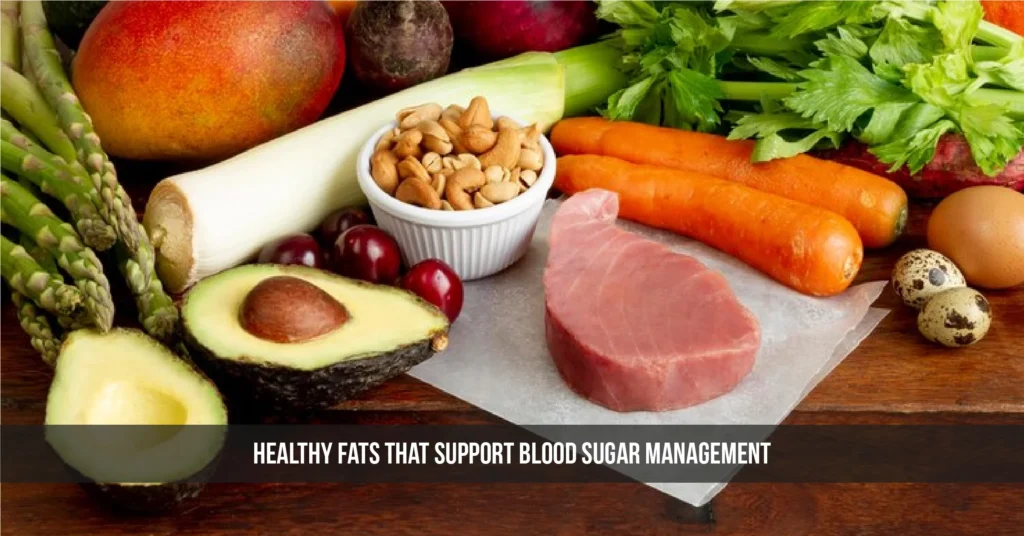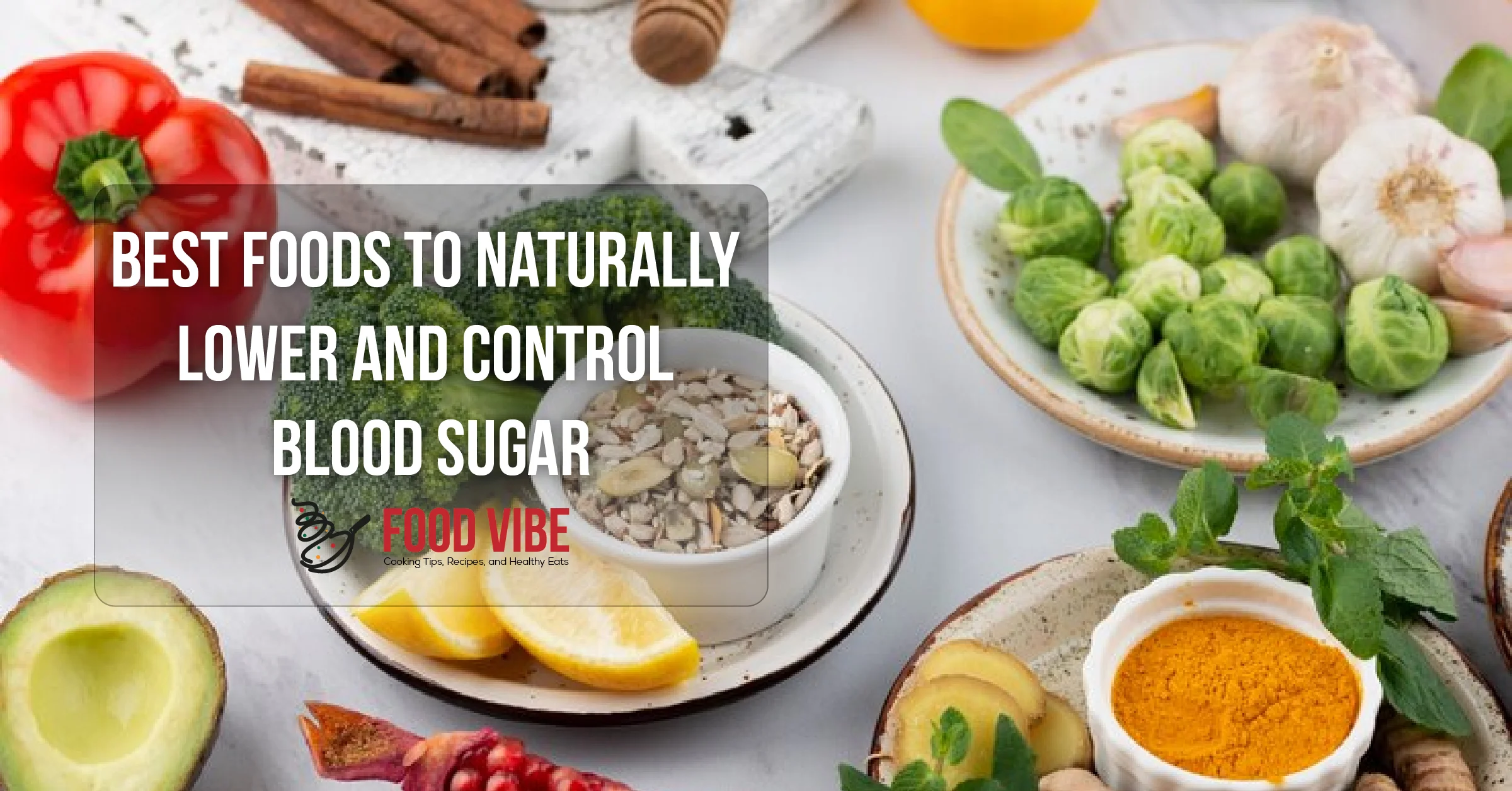Best Foods to Naturally Lower and Control Blood Sugar
Managing blood sugar is key for your health, especially with diabetes. What you eat greatly affects your blood sugar levels. Eating the right foods can help control blood sugar naturally.
Recent data from the American Diabetes Association shows nearly 37 million Americans have diabetes. This highlights the need for good dietary habits. In this article, you’ll find foods that help control blood sugar and boost your health.
Table of Contents
Understanding Blood Sugar and Its Importance
Blood sugar, or glucose, is the main energy for your body’s cells. Keeping blood sugar stable is key to good health. Changes in blood sugar can cause big health issues, especially for those with diabetes. Knowing how food and lifestyle affect glucose levels is crucial for managing blood sugar.
Eating a healthy diet is vital for diabetes management. It involves eating whole, nutrient-rich foods to keep blood sugar stable. Eating balanced meals at set times helps avoid energy crashes or mood swings. Foods high in fiber, lean proteins, and healthy fats are great for managing blood sugar.
“Good blood sugar management is essential to avoid complications linked to diabetes, such as cardiovascular disease and nerve damage.”
The Centers for Disease Control and Prevention (CDC) shows the dangers of uncontrolled blood sugar. A healthy diet for diabetes is very important. By knowing how different foods affect blood sugar, you can make better choices for your health.
| Blood Sugar Level Range | Effect on Health |
|---|---|
| Below 70 mg/dL | Hypoglycemia (low blood sugar), possible confusion, dizziness |
| 70-130 mg/dL | Normal fasting blood sugar for most individuals |
| Above 130 mg/dL | Potential for hyperglycemia (high blood sugar), increased risk of diabetes complications |
Best Foods That Help Lower and Control Blood Sugar Naturally
Adding certain foods to your diet can really help with blood sugar levels. These foods, called diabetes superfoods, are not only nutritious but also help keep blood sugar in check. We’ll look at two important groups: leafy greens and berries.
Leafy Greens and Their Benefits
Leafy greens like spinach, kale, and Swiss chard are super healthy. They are low in calories but full of good stuff. They have lots of fiber, which is great for your digestion and blood sugar.
Eating these foods often can make your body better at using insulin. This makes them a big part of foods to lower blood sugar levels.
Berries: A Sweet Solution
Berries like strawberries, blueberries, and blackberries are tasty and good for you. They are full of antioxidants and don’t raise blood sugar much. Berries also have nutrients that help your body work better.
They are a fun way to add diabetes superfoods to your meals.
| Food | Benefits | Nutritional Highlights |
|---|---|---|
| Spinach | Improves insulin sensitivity | Vitamins A, C, K |
| Kale | Rich in antioxidants | Vitamins C, K, Calcium |
| Strawberries | Supports metabolic health | High in Vitamin C |
| Blueberries | Enhances insulin response | Fibers, Antioxidants |
| Blackberries | Low calorie | High in fiber |
Incorporating Whole Grains into Your Diet
Whole grains are key for managing blood sugar. They have fiber and nutrients that keep blood sugar stable. Adding these grains to your meals helps control blood sugar naturally.
Fibrous Grains for Better Blood Sugar Control
Fibrous grains help keep blood sugar balanced. Foods like quinoa, brown rice, and barley are full of nutrients. They slow down digestion, which helps prevent blood sugar spikes.
Adding these grains to your diet can improve blood sugar control. It’s a simple way to support your health.
Choosing the Right Whole Grains
Look for “100% whole grain” labels to get the most nutrients. Here are some good options:
- Quinoa
- Brown rice
- Barley
- Oats
- Whole wheat pasta
Adding these grains to your meals boosts your diet. They’re great in salads, stir-fries, or as sides. Choosing the right grains helps manage diabetes effectively.
Healthy Fats That Support Blood Sugar Management
Adding healthy fats to your diet is key for managing diabetes. Foods like avocados, nuts, and olive oil are rich in these fats. They help slow down how carbs are absorbed, keeping blood sugar levels steady.
Studies show that eating healthy fats regularly can improve diabetic health. These fats make you feel full, helping you eat less and stay at a healthy weight. They also lower the blood sugar spike from carbs when eaten together.
“A well-rounded diet rich in healthy fats yields positive effects on blood sugar control and overall metabolic health.”
Here’s a table of common healthy fats and their benefits:
| Source | Health Benefits |
|---|---|
| Avocados | Rich in monounsaturated fats and fiber, promotes heart health, and helps stabilize blood sugar. |
| Nuts (e.g., almonds, walnuts) | Provide omega-3 fatty acids, support weight management, and reduce inflammation. |
| Olive Oil | Contains antioxidants, improves insulin sensitivity, and aids cardiovascular health. |
| Chia Seeds | High in omega-3s and fiber, contribute to increased fullness and improved digestive health. |
| Fatty Fish (e.g., salmon, mackerel) | Rich in omega-3s, supports heart health, and may lower blood sugar levels. |
Adding these healthy fats to your meals can greatly improve your health and diabetes management. Making these dietary changes not only helps with blood sugar but also boosts overall well-being.

Legumes: A Diabetic-Friendly Protein Source
Legumes like beans, lentils, and chickpeas are great for people with diabetes. They are full of fiber and have a low glycemic index. This makes them a good choice for managing blood sugar levels.
Eating foods that lower blood sugar, like legumes, can help prevent spikes. This keeps your glucose levels stable all day.
How Legumes Help Stabilize Blood Sugar
Legumes offer more than just protein. They are also high in dietary fiber, which helps with digestion. This slows down how quickly glucose is absorbed into the blood.
This slow absorption helps keep blood sugar levels stable. Studies show that legumes can be a natural way to manage diabetes better.
- High in fiber, promoting better digestive health
- Low in glycemic index, leading to gradual glucose absorption
- Rich in vitamins and minerals that support overall health
Adding legumes to your meals can be fun and healthy. Try them in salads, soups, or as a side dish. They help lower blood sugar and make your meals more satisfying and nutritious.
| Type of Legume | Protein Content (per 100g) | Fiber Content (per 100g) | Glycemic Index |
|---|---|---|---|
| Chickpeas | 19g | 7.6g | 28 |
| Lentils | 26g | 8g | 21 |
| Black Beans | 21g | 8.7g | 30 |
| Kidney Beans | 24g | 6.4g | 29 |
Adding legumes to your diet can lead to healthier eating. It also helps manage blood sugar levels. Try different recipes and cooking methods to enjoy the many uses of legumes.
Spices and Herbs That Lower Blood Sugar Levels
Adding certain spices and herbs to your meals can help manage blood sugar. These ingredients not only make food taste better but also offer health benefits. They act as natural remedies for diabetes.
Cinnamon: Nature’s Sweetener
Cinnamon is known for its ability to improve insulin sensitivity. Studies show it can lower fasting blood sugar levels. It’s a great addition to oatmeal, smoothies, or coffee for a tasty and healthy boost.
Turmeric and Its Anti-Inflammatory Benefits
Turmeric, with its active ingredient curcumin, is famous for fighting inflammation. It also helps improve metabolic health. Adding turmeric to your meals can help control blood sugar. Enjoy it in curries, teas, or as a supplement for its health perks. Using these spices can support your overall health and well-being.
| Spice/Herb | Key Benefit | How to Use |
|---|---|---|
| Cinnamon | Improves insulin sensitivity | Sprinkle on cereals, add to beverages |
| Turmeric | Anti-inflammatory properties | Incorporate in cooking, teas, or smoothies |
Low-Glycemic Index Foods for Steady Energy Levels
The glycemic index (GI) is a key tool for managing blood sugar through diet. It ranks foods by how fast they raise blood sugar. Low-GI foods slowly release glucose, giving steady energy and helping control blood sugar naturally.
Understanding Glycemic Index
Knowing the glycemic index is key to a good diet. Foods with a GI of 55 or less help keep blood sugar stable. Adding these to your meals can prevent energy ups and downs all day.
Examples of Low-GI Foods
Here are some great low-GI foods for a balanced diet:
| Food Item | Glycemic Index | Benefits |
|---|---|---|
| Non-Starchy Vegetables | 15 | Rich in fiber, low in calories |
| Whole Oats | 55 | Great source of soluble fiber, aids digestion |
| Sweet Potatoes | 44 | High in vitamins, supports immune function |
| Quinoa | 53 | Complete protein source, gluten-free |
| Legumes (Beans, Lentils) | 30-40 | High in protein and fiber, helps with fullness |
Eating these low-GI foods daily can help control blood sugar. This ensures steady energy and better health.

Omega-3 Fatty Acids and Their Role in Blood Sugar Control
Adding omega-3 fatty acids to your diet can help if you manage diabetes with diet. These fats, found in fish like salmon and in plants like flaxseeds, improve how well your body uses insulin. This is crucial for controlling blood sugar levels.
Studies show that omega-3s help manage blood sugar and reduce body inflammation. Inflammation can make it harder for your body to control blood sugar. So, eating these fats can help with blood sugar and heart health.
Here’s a breakdown of some rich sources of omega-3 fatty acids and their benefits:
| Food Source | Omega-3 Content (per serving) | Benefits |
|---|---|---|
| Salmon (3.5 oz) | 2260 mg | Improves insulin sensitivity and reduces inflammation |
| Flaxseeds (2 tbsp) | 2338 mg | Supports heart health and lowers blood sugar spikes |
| Chia Seeds (2 tbsp) | 4915 mg | Aids in blood sugar stabilization and provides fiber |
| Walnuts (1 oz) | 2542 mg | Promotes heart health and may aid in weight management |
Eating foods rich in omega-3s can help control blood sugar. It’s a key part of managing diabetes with diet. Regularly eating these foods supports your health goals.
Importance of a Balanced Diet in Managing Diabetes
Eating a balanced diet is key to keeping blood sugar levels in check. A variety of foods ensures you get all the nutrients you need. This helps manage blood sugar levels well. Planning your meals for diabetes can make it easier to live a healthy life and enjoy food without worrying about blood sugar spikes.
Meal Planning Tips for a Healthy Diet
Good meal planning for diabetes means watching portion sizes, counting carbs, and mixing foods. Here are some tips for balanced meals:
- Focus on whole foods like fruits, veggies, whole grains, lean proteins, and healthy fats.
- Make sure your plate has different colors to get a variety of nutrients.
- Use measuring cups or a food scale to keep portions right.
- Prepare meals ahead of time to avoid unhealthy choices.
- Always check food labels to know the carb content for better blood sugar control.
Balancing Macronutrients for Optimal Health
Knowing about macronutrients helps you make better food choices. Here’s what you need to know:
| Macronutrient | Sources | Recommended Proportion |
|---|---|---|
| Carbohydrates | Whole grains, legumes, fruits, vegetables | 45-60% of daily intake |
| Proteins | Lean meats, fish, dairy, legumes | 15-20% of daily intake |
| Fats | Avocados, nuts, seeds, olive oil | 20-35% of daily intake |
By balancing these nutrients, you meet your body’s needs and control blood sugar. A smart nutrition plan helps you manage your health and well-being.

Staying Hydrated: The Unsung Hero in Blood Sugar Control
Drinking enough water is key for managing blood sugar. It helps your kidneys work better, getting rid of extra sugar in your urine. This is a big help in keeping your blood sugar levels in check.
- Drinking water helps you feel less thirsty and hungry. This makes it easier to follow your meal plan and eat foods that help lower blood sugar.
- Water helps control blood sugar levels. It’s a must-do part of your daily routine.
- Staying hydrated keeps your cells working well and boosts your energy. This lets you do more physical activities that help manage blood sugar.
Adding hydration to your life is simple. Here are some tips:
- Always carry a water bottle to remind you to drink.
- Set goals for how much water you want to drink each day.
- Eat foods with lots of water, like cucumbers, oranges, and lettuce.
Understanding how important hydration is can help you control blood sugar better. By focusing on hydration, you add another tool to your health toolkit.
Conclusion
Understanding how your diet affects blood sugar is crucial. Foods like leafy greens, whole grains, and legumes are great for controlling blood sugar. They provide important nutrients that help keep blood sugar stable and support overall health.
For effective diabetes management, a balanced diet is essential. Adding low-glycemic index foods and healthy fats, along with spices like cinnamon and turmeric, can help manage glucose levels. Making smart food choices is a key step towards better health.
Start making these changes a part of your daily life. Focusing on nutrition can help regulate blood sugar and improve your overall health. It’s a step towards a healthier, more vibrant life.
Also Read: 5 Superfoods to Help Manage Insulin Resistance
FAQs
What are the best foods to help lower blood sugar naturally?
Foods like leafy greens, berries, whole grains, legumes, and healthy fats (e.g., avocados, nuts) are excellent for stabilizing blood sugar and improving insulin sensitivity.
How do whole grains help manage blood sugar levels?
Whole grains, such as quinoa and brown rice, are high in fiber, which slows digestion and prevents blood sugar spikes, making them ideal for diabetes management.
Can spices like cinnamon and turmeric help control blood sugar?
Yes, cinnamon improves insulin sensitivity, while turmeric’s anti-inflammatory properties support metabolic health, making them great natural remedies for diabetes.
Why are omega-3 fatty acids important for blood sugar control?
Omega-3s, found in fatty fish and flaxseeds, enhance insulin sensitivity and reduce inflammation, helping to stabilize blood sugar levels and support overall health.
How does hydration impact blood sugar management?
Staying hydrated helps kidneys flush out excess sugar, reduces hunger, and supports energy levels, making it a key factor in maintaining stable blood sugar.














Post Comment